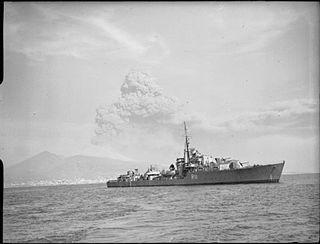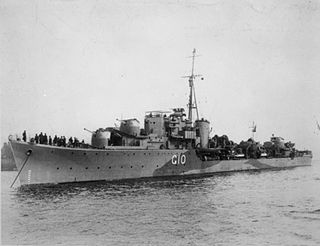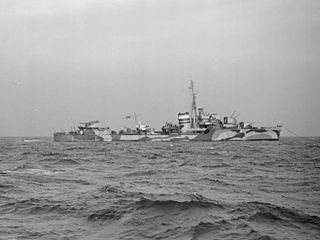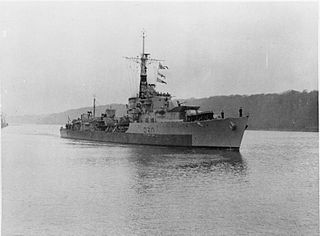
HMS Kandahar (F28) was a K-class destroyer built for the Royal Navy during the 1930s, named after the Afghan city of Kandahar.

ORP Orkan, formerly HMS Myrmidon, was an M-class destroyer of the Polish Navy during World War II. Orkan is Polish for "hurricane".

HMS Penn was a P-class destroyer built for the Royal Navy during the Second World War.
HMS Owen was a Bay-class frigate built for the Royal Navy during World War 2.

HMS Tumult was a T-class destroyer built for the Royal Navy during the Second World War.

HMS Tyrian was a S-class destroyer built for the Royal Navy during the Second World War.

HNoMS Svenner was a Royal Norwegian Navy destroyer during the Second World War. She was built for the Royal Navy as the S-class destroyer HMS Shark but on completion was lent to the Norwegian Armed Forces in exile. Svenner was sunk off Sword, one of the Allied landing zones in Normandy, at dawn on 6 June 1944 while supporting the British Army Normandy landings. It was the only Allied ship to be sunk by the Kriegsmarine during the morning of the invasion.

HMS Scourge was an S-class destroyer built for the Royal Navy during the Second World War. The ship was sold to the Netherlands postwar, where it saw action in the Korean War and the West New Guinea dispute.

HMS Racehorse was a R-class destroyer built for the Royal Navy during the Second World War.

HMS Redoubt was an R-class destroyer built for the Royal Navy during the Second World War.

HMS Pathfinder was a P-class destroyer built for the Royal Navy during the Second World War. She was damaged while serving in the Far East, and was scrapped after the end of the war.

HMS Milne was a M-class destroyer of the Royal Navy which served during World War II. She was equipped as a flotilla leader.

HMS Consort was one of thirty-two C-class destroyers built for the Royal Navy during the Second World War, a member of the eight-ship Co sub-class.

HMS Loyal was a L-class destroyer built for the Royal Navy in the late 1930s, although she was not completed until after World War II had begun.

HMS Carron was one of thirty-two C-class destroyers built for the Royal Navy during the Second World War, a member of the eight-ship Ca sub-class. Commissioned in late 1944, she was assigned to the Home Fleet and escorted the fleet's larger ships during operations off German-occupied Norway. Carron was sold for scrap in 1967.

HMS Cavendish was one of eight C-class destroyers built for the Royal Navy during the Second World War. Commissioned in late 1944, she was built as a flotilla leader with additional accommodation for staff officers. The ship was assigned to the Home Fleet in 1945 after working up where she escorted capital ships of the fleet. Cavendish was sold for scrap in 1967.

HMS Caesar was one of thirty-two C-class destroyers built for the Royal Navy during the Second World War, a member of the eight-ship Ca sub-class. Commissioned in 1944, she was built as a flotilla leader with additional accommodation for staff officers. The ship was assigned to Home Fleet during 1944–1945 and escorted one Arctic convoy as well as the capital ships of the fleet.

HMS Cheviot was one of thirty-two C-class destroyers built for the Royal Navy during the Second World War, a member of the eight-ship Ch sub-class. Completed after the war, she was sold for scrap in 1962.

HMS Chivalrous was one of thirty-two C-class destroyers built for the Royal Navy during the Second World War, a member of the eight-ship Ch sub-class. Commissioned in 1946, she was built as a flotilla leader with additional accommodation for staff officers. The ship was loaned to the Pakistani Navy during the late 1950s and was sold for scrap in 1961 after being returned.

HMS Comet was one of thirty-two C-class destroyers built for the Royal Navy during the Second World War, a member of the eight-ship Co sub-class.



















